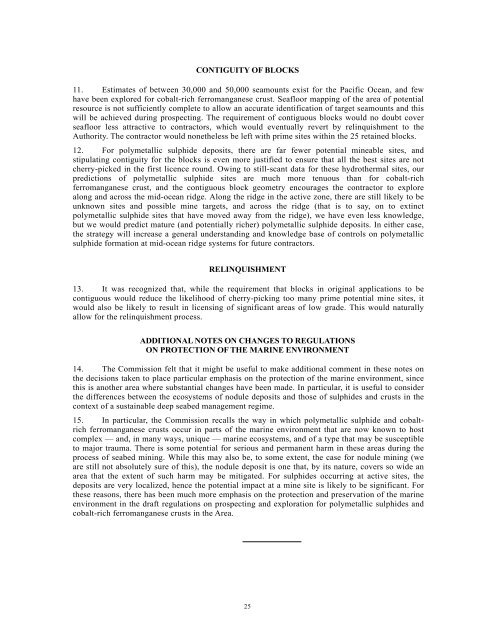Selected Decisions and Documents of the Eleventh Session
Selected Decisions and Documents of the Eleventh Session
Selected Decisions and Documents of the Eleventh Session
You also want an ePaper? Increase the reach of your titles
YUMPU automatically turns print PDFs into web optimized ePapers that Google loves.
CONTIGUITY OF BLOCKS<br />
11. Estimates <strong>of</strong> between 30,000 <strong>and</strong> 50,000 seamounts exist for <strong>the</strong> Pacific Ocean, <strong>and</strong> few<br />
have been explored for cobalt-rich ferromanganese crust. Seafloor mapping <strong>of</strong> <strong>the</strong> area <strong>of</strong> potential<br />
resource is not sufficiently complete to allow an accurate identification <strong>of</strong> target seamounts <strong>and</strong> this<br />
will be achieved during prospecting. The requirement <strong>of</strong> contiguous blocks would no doubt cover<br />
seafloor less attractive to contractors, which would eventually revert by relinquishment to <strong>the</strong><br />
Authority. The contractor would none<strong>the</strong>less be left with prime sites within <strong>the</strong> 25 retained blocks.<br />
12. For polymetallic sulphide deposits, <strong>the</strong>re are far fewer potential mineable sites, <strong>and</strong><br />
stipulating contiguity for <strong>the</strong> blocks is even more justified to ensure that all <strong>the</strong> best sites are not<br />
cherry-picked in <strong>the</strong> first licence round. Owing to still-scant data for <strong>the</strong>se hydro<strong>the</strong>rmal sites, our<br />
predictions <strong>of</strong> polymetallic sulphide sites are much more tenuous than for cobalt-rich<br />
ferromanganese crust, <strong>and</strong> <strong>the</strong> contiguous block geometry encourages <strong>the</strong> contractor to explore<br />
along <strong>and</strong> across <strong>the</strong> mid-ocean ridge. Along <strong>the</strong> ridge in <strong>the</strong> active zone, <strong>the</strong>re are still likely to be<br />
unknown sites <strong>and</strong> possible mine targets, <strong>and</strong> across <strong>the</strong> ridge (that is to say, on to extinct<br />
polymetallic sulphide sites that have moved away from <strong>the</strong> ridge), we have even less knowledge,<br />
but we would predict mature (<strong>and</strong> potentially richer) polymetallic sulphide deposits. In ei<strong>the</strong>r case,<br />
<strong>the</strong> strategy will increase a general underst<strong>and</strong>ing <strong>and</strong> knowledge base <strong>of</strong> controls on polymetallic<br />
sulphide formation at mid-ocean ridge systems for future contractors.<br />
RELINQUISHMENT<br />
13. It was recognized that, while <strong>the</strong> requirement that blocks in original applications to be<br />
contiguous would reduce <strong>the</strong> likelihood <strong>of</strong> cherry-picking too many prime potential mine sites, it<br />
would also be likely to result in licensing <strong>of</strong> significant areas <strong>of</strong> low grade. This would naturally<br />
allow for <strong>the</strong> relinquishment process.<br />
ADDITIONAL NOTES ON CHANGES TO REGULATIONS<br />
ON PROTECTION OF THE MARINE ENVIRONMENT<br />
14. The Commission felt that it might be useful to make additional comment in <strong>the</strong>se notes on<br />
<strong>the</strong> decisions taken to place particular emphasis on <strong>the</strong> protection <strong>of</strong> <strong>the</strong> marine environment, since<br />
this is ano<strong>the</strong>r area where substantial changes have been made. In particular, it is useful to consider<br />
<strong>the</strong> differences between <strong>the</strong> ecosystems <strong>of</strong> nodule deposits <strong>and</strong> those <strong>of</strong> sulphides <strong>and</strong> crusts in <strong>the</strong><br />
context <strong>of</strong> a sustainable deep seabed management regime.<br />
15. In particular, <strong>the</strong> Commission recalls <strong>the</strong> way in which polymetallic sulphide <strong>and</strong> cobaltrich<br />
ferromanganese crusts occur in parts <strong>of</strong> <strong>the</strong> marine environment that are now known to host<br />
complex — <strong>and</strong>, in many ways, unique — marine ecosystems, <strong>and</strong> <strong>of</strong> a type that may be susceptible<br />
to major trauma. There is some potential for serious <strong>and</strong> permanent harm in <strong>the</strong>se areas during <strong>the</strong><br />
process <strong>of</strong> seabed mining. While this may also be, to some extent, <strong>the</strong> case for nodule mining (we<br />
are still not absolutely sure <strong>of</strong> this), <strong>the</strong> nodule deposit is one that, by its nature, covers so wide an<br />
area that <strong>the</strong> extent <strong>of</strong> such harm may be mitigated. For sulphides occurring at active sites, <strong>the</strong><br />
deposits are very localized, hence <strong>the</strong> potential impact at a mine site is likely to be significant. For<br />
<strong>the</strong>se reasons, <strong>the</strong>re has been much more emphasis on <strong>the</strong> protection <strong>and</strong> preservation <strong>of</strong> <strong>the</strong> marine<br />
environment in <strong>the</strong> draft regulations on prospecting <strong>and</strong> exploration for polymetallic sulphides <strong>and</strong><br />
cobalt-rich ferromanganese crusts in <strong>the</strong> Area.<br />
25
















